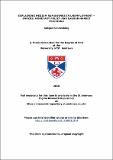Files in this item
Explaining medium run swings in unemployment : shocks, monetary policy and labour market frictions
Item metadata
| dc.contributor.advisor | Hughes-Hallett, Andrew | |
| dc.contributor.advisor | Nolan, Charles | |
| dc.contributor.author | Rannenberg, Ansgar | |
| dc.coverage.spatial | xvi, 289 | en_US |
| dc.date.accessioned | 2010-08-25T10:27:38Z | |
| dc.date.available | 2010-08-25T10:27:38Z | |
| dc.date.issued | 2010 | |
| dc.identifier | uk.bl.ethos.552444 | |
| dc.identifier.uri | https://hdl.handle.net/10023/974 | |
| dc.description.abstract | The literature trying to link the increase in unemployment in many western European countries since the middle of the 1970s to an increase in labour market rigidity has run into a number of problems. In particular, changes in labour market institutions do not seem to be able to explain the evolution of unemployment across time. We conclude that a new theory of medium run unemployment swings should explain the increase in unemployment in many European countries and the lack thereof in the United States. Furthermore, it should also help to explain the high degree of endogenous unemployment persistence in the many European countries and findings suggesting a link between disinflationary monetary policy and subsequent increases in the NAIRU. To address these issues, we first develop an endogenous growth sticky price model. We subject the model to an uncorrelated cost push shock, in order to mimic a scenario akin to the one faced by central banks at the end of the 1970s. Monetary policy implements a disinflation by following an interest feedback rule calibrated to an estimate of a Bundesbank reaction function. 40 quarters after the shock has vanished, unemployment is still about 1.8 percentage points above its steady state. The model also partly explains cross country differences in the unemployment evolution by drawing on differences in the size of the disinflation, the monetary policy reaction function and wage setting. We then draw some conclusions about optimal monetary policy in the presence of endogenous growth and find that optimal policy is substantially less hawkish than in an identical economy without endogenous growth. The second model introduces duration dependent skill decay among the unemployed into a New-Keynesian model with hiring frictions developed by Blanchard/Gali (2008). If the central bank responds only to inflation and quarterly skill decay is above a threshold level, determinacy requires a coefficient on inflation smaller than one. The threshold level is plausible with little steady-state hiring and firing ("Continental European Calibration") but implausibly high in the opposite case ("American calibration"). Neither interest rate smoothing nor responding to the output gap helps to restore determinacy if skill decay exceeds the threshold level. However, a modest response to unemployment guarantees determinacy. Moreover, under indeterminacy, both an adverse sunspot shock and an adverse technology shock increase unemployment extremely persistently. | en_US |
| dc.language.iso | en | en_US |
| dc.publisher | University of St Andrews | |
| dc.subject.lcc | HD5764.A6R2 | |
| dc.subject.lcsh | Unemployment--Europe | en_US |
| dc.subject.lcsh | Unemployment--Effect of monetary policy on--Europe | en_US |
| dc.subject.lcsh | Monetary policy--Europe | en_US |
| dc.subject.lcsh | Labor market--Europe | en_US |
| dc.title | Explaining medium run swings in unemployment : shocks, monetary policy and labour market frictions | en_US |
| dc.type | Thesis | en_US |
| dc.type.qualificationlevel | Doctoral | en_US |
| dc.type.qualificationname | PhD Doctor of Philosophy | en_US |
| dc.publisher.institution | The University of St Andrews | en_US |
This item appears in the following Collection(s)
Items in the St Andrews Research Repository are protected by copyright, with all rights reserved, unless otherwise indicated.

